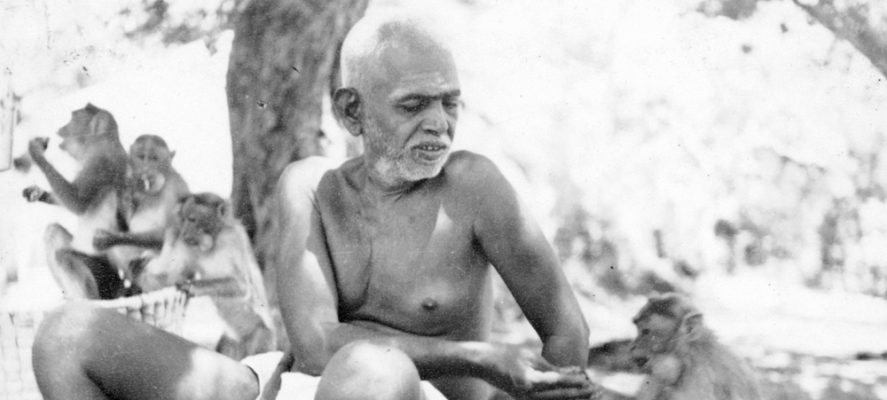
The following brief conversation comes from the diary of a devotee called Sri Yalamanchili who met Bhagavan in 1928 and had a discussion with him on self-enquiry. It was published in Arunachala Ramana in February 1982. It is a succinct and elegant summary of many of the aspects of self-enquiry.
Question: How to realise the Atman?
Bhagavan: Whose Atman?
Question: Mine.
Bhagavan: Then you yourself have to do it.
Question: I am unable to do and know it.
Bhagavan: To whom is it not known?
Question: To myself.
Bhagavan: Try to know who is that ‘myself’.
Question: That is what you have to tell.
Bhagavan: [Smiling] It seems you have come here to test me. Will it really benefit you if I tell you what you are? Will you be satisfied if I just tell you? Ask yourself ‘Who am I?’ After questioning you will get the answer within yourself, and that will satisfy you.
Question: I have been doing sadhana for a long time but in vain.
Bhagavan: You will have to search for ‘I’ [aham]. Then, the apparent ‘I’ will vanish.
Question: Please give me the details of the process.
Bhagavan: Mind is, in reality, a bundle of thoughts. And every thought springs from the ‘I’. So, it is the first thought. Instead of dwelling on the secondary thoughts, the seeker has to concentrate on the primary thought, which is this ‘I’.
Question: What is the difference between a thought and the ‘I’?
Bhagavan: Thoughts are not independent. They have a standing only when they are associated with the ‘I’. But the ‘I’ can stand by itself. Actually, this ‘I’ is also not independent. In its turn it is supported by the Atman. Again and again it rises from the Self and sinks there. It subsides in deep sleep and it comes out again in waking. We have to find out the place of its birth with an introverted vision.
Question: I have been questioning in this way but getting no answer.
Bhagavan: If you ask this question with zeal and proceed inward, the false ‘I’ disappears and the real ‘I’ emerges.
Question: What is the real ‘I’?
Bhagavan: This is what we call ‘soul’ or ‘God’.
Question: When I start the enquiry numerous thoughts come in the way and obstruct me. When I eliminate one, another appears in its place. It seems there is no end.
Bhagavan: I am not telling you to grapple with the thoughts. There will be no end if you do it that way. Here lies the secret: there is the ‘I’, the source of all thoughts, and we have to catch it and see from where it arises. This is absolutely necessary. As a dog traces his master by following the track of his smell, you have to follow the inner development of the ‘I’ to reach its source, which is the [true] soul.
Question: From this I understand that one can reach the source by one’s own effort.
Bhagavan: It is by the grace of God that you come to desire to know yourself. This desire to know yourself is itself a clear sign of the Atman’s grace. So, there is grace already working as the source of your effort. Grace is not an external quality of the Self but its very nature. It abides in your Heart, pulling you inward into itself. The only task you must do is turn your attention inward and search the source of ‘I’. This is the only personal effort we have to put in. That is why [one can say that] where there is no grace, there is no desire at all for the quest for the Self.
Question: Is there no need for a Guru then?
Bhagavan: When it is necessary the Self itself will take the form of an external Guru and initiate you into the process. He will push you in and hand you over to the inner Guru who is already there. Finally, the Atman, which abides in the Heart, embraces you there.
Question: Now, may I know sir, what is the distinguishing feature of this method?
Bhagavan: The sense of ‘I’ is always present in us. So, it is relatively easy to find the Self through this ‘I’, which is an emanation of the Self. Further, if, before the ‘I’ ramifies into many forms, we put our attention via this method on the parent-form of the ‘I’, this makes for the direct dissolution of the ‘I’ in its source. Otherwise, if you begin the enquiry when the ‘I’ has already taken many forms, you will be swept away by its illusive power and never reach its source.
Question: The Self is nameless and formless. How then can we find it by the questioning of this ‘I’ that has a name and a form?
Bhagavan: The false ‘I’ or ego stands between the soul and the body, and connects them. Now, soul is conscious while the body is inert. The false ‘I’ binds them together. So, it is also called the knot between matter and spirit [chit-jada-granthi]. From this we see that it has its feet in the Self and its head in the body. Therefore, by enquiring into the origin of the ego, we can easily proceed and reach the formless Self.